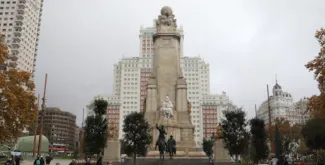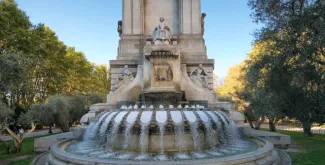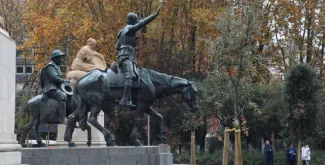Welcome to Madrid
The monument to Cervantes was commissioned by King Alfonso XIII in 1915, on the 300th anniversary of the publication of the second part of Don Quixote. The main body of the fountain was erected in the 1920’s, but the full monument was not completed until the 1960’s, when the sculptures of Aldonza and Dulcinea were added on the side.
This grandiose monument, located in the Plaza de España, is structured into two main bodies that culminate in a top piece. The figures of Don Quixote and his loyal squire, Sancho Panza, stand on the central pedestal, inviting passers-by to stop and look at them as they walk past.
The contrast between imagination and reality is reflected in the two bronze figures which, unlike the other stone sculpture, are made of bronze. Behind them, presiding over the group, is the figure of Cervantes himself, holding a copy of Don Quixote. The sides are decorated with scenes from La Gitanilla (right,) and Rinconete y Cortadillo (left). The rear section is presided over by a female figure, symbolising Spanish literature. At her feet lies a fountain featuring the coats of arms of all the Latin American countries, and in the top section we can see figures representing the five continents, holding up a globe with an allegorical figure of Fame or Victory, which symbolises the universal quality of Cervantes’ work.



Docking station: Plaza de España A y B (calle Princesa, 1)
Free access.
